ST. ANGELA ACADEMY IN AIKEN, SC
Having outgrown the smaller building on York Street, St. Angela Academy was moved in the early 1950s to the former Elbert Estate on Berrie Road. Ridgeley Hall, which adjoined the school, was the convent and residence for the nuns and the boarding students. On this page is an article from the Aiken Standard, some photos from March 1999 of the place where the school building once existed, and some detail and photos of Ridgeley Hall.
Here is an article from the Aiken Standard and Review, January 21, 1999, that tells some of the story of the Berrie Road school. The images are thumbnails. If you click inside the thumbnail image, a larger one will appear.
ST. ANGELA ACADEMY, WHERE GENERATIONS OF AIKEN'S CATHOLIC YOUTH
STUDIED, FALLING BRICK BY BRICK
By Loren Schneider
 Last month, St. Angela Academy, a former Catholic high school located on Berrie Road, was partially razed to the dismay of many former graduates of the school.
Last month, St. Angela Academy, a former Catholic high school located on Berrie Road, was partially razed to the dismay of many former graduates of the school.
"St. Angela Academy meant so much to so many people," said Sally Anaclerio, a 1955 graduate of the school. "The school itself had a history of 92 years in Aiken. To the people who went there, we had something extremely special in our lives. And, we have quite an alliance to the school."
Mrs. Agnes Donavon Ford, a 1929 graduate, said she was proud of the school. "I was always proud that I could say I went to St. Angela Academy. It was really a nice school. My daughter went there (on Berrie Road) and graduated in the 1950s. She loved St. Angela Academy too."
St. Angela Academy was founded in 1900 and was first located on the corner of Richland Avenue and Pendleton Street. The school's founders were the Ursulines, a Catholic teaching order. In 1912, the school moved to the intersection of Richland Avenue and York Street, in what was known at the time as the Busch House. The relocation was necessary to accommodate an increase in enrollment at the school.
 "I did attend St. Angela Academy when St. Angela Academy was on York Street," said Rosamond McDuffie. "There was a gorgeous white home on the property where the nuns and boarding students lived. There was a beautiful chapel on the first floor and the dining room was in there. We held tea dances on Sundays and we invited local boys in and the nuns chaperoned us. We spent wholesome and happy times there. I wept when they tore that building down; it was so sad.
"I did attend St. Angela Academy when St. Angela Academy was on York Street," said Rosamond McDuffie. "There was a gorgeous white home on the property where the nuns and boarding students lived. There was a beautiful chapel on the first floor and the dining room was in there. We held tea dances on Sundays and we invited local boys in and the nuns chaperoned us. We spent wholesome and happy times there. I wept when they tore that building down; it was so sad.
"The nuns instructed us in sports. Sister Carmel taught tennis and her skirts would get in the way when she ran around, so she would wrap them around her and pin them up with clothes pins. She would still be wearing her black socks and habit because she didn't change. It didn't stop her. Everyone was content and happy there. We worked and studied hard and we played hard. It was wonderful."
When the Savannah River Plant opened in 1950, the population in Aiken County increased, along with enrollment at the academy. During that year, an 11 acre tract of land on Berrie Road was purchased. The land was the former Elbert estate. In 1953, the new St. Angela Academy was dedicated and high school classes moved in to the new site while the elementary students remained at St. Mary's under the supervision of the St Mary Help of Christians Catholic Church.
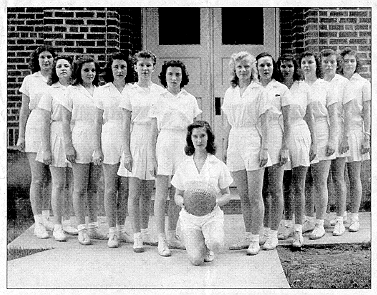 "A lot of us went to that building on York Street," said Mary Catherine Cunning, older sister of Mrs. Anaclerio. "I graduated in 1953 and I was in the last graduating class in that building before it moved to Berrie Road. When we graduated, we had our reception on the grounds on Berrie Road but we didn't think that was unusual. In my recollection, it was a normal thing to do. The fact that we were the last class, I don't remember doing anything special because of that. But that didn't mean that much to us back then. We were young and excited about graduating and looking ahead to our futures. And, we didn't expect the school to be closing. It never entered our minds."
"A lot of us went to that building on York Street," said Mary Catherine Cunning, older sister of Mrs. Anaclerio. "I graduated in 1953 and I was in the last graduating class in that building before it moved to Berrie Road. When we graduated, we had our reception on the grounds on Berrie Road but we didn't think that was unusual. In my recollection, it was a normal thing to do. The fact that we were the last class, I don't remember doing anything special because of that. But that didn't mean that much to us back then. We were young and excited about graduating and looking ahead to our futures. And, we didn't expect the school to be closing. It never entered our minds."
At the new site on Berrie Road, the St. Angela Academy was operated by the Sisters of Charity of Our Lady of Mercy. The historic Ridgeley Hall, built by Aiken winter colony resident Winthrop Rutherfurd in 1928, became a convent for the nuns.
In the first graduating class at Berrie Road, in 1954, was Richard Sullivan.
"I was senior class president of the first class coming out of the Berrie Road school. I always thought being part of the first graduating class was a highlight of my life," he said. "We were bursting at the seams to get to go to the new school. There was a gym and the old school didn't have one.
"The community supported us. We had festivals to raise money and the community really donated to those festivals. The festivals would bring together the whole community for the purpose of that school. We had really good times together."
Unfortunately, St. Angela Academy closed in June of 1988 because of gradual declines in enrollment and financial hardships.
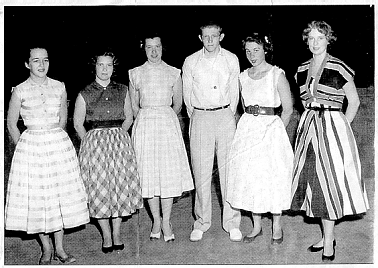 "It was absolutely devastating to us when it closed," said Mrs. Anaclerio. "It was worse than losing a member of our family. It was an institution. We were very upset when the county would not support the school. It had such a long and wonderful history, and Aiken lost a real gem when we lost that school. It's like anything else that you care passionately about."
"It was absolutely devastating to us when it closed," said Mrs. Anaclerio. "It was worse than losing a member of our family. It was an institution. We were very upset when the county would not support the school. It had such a long and wonderful history, and Aiken lost a real gem when we lost that school. It's like anything else that you care passionately about."
In the early 1990s, Joel Conte, who owns General Gold Products and Facets, a retail jewelry business, purchased the property from the Catholic order. He turned the classrooms into stables and the school's gymnasium was converted to a barn and used for hay storage.
Mrs. Anaclerio said, "That building was built in the 1950s. Then to turn it into a horse stable, we don't want to remember that. It is such a shame."
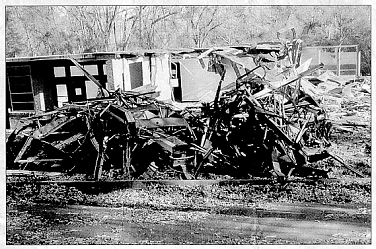 Since then, the property has been unused, and last month, a work crew showed up at the former school to raze the building.
Since then, the property has been unused, and last month, a work crew showed up at the former school to raze the building.
Work was halted by the Aiken Department of Public Safety because the crew did not have approval or a permit. However, one end of the school was reduced to a pile of rubble before the crew was stopped.
"In our family, we had a couple of generations that went there," said Ms. Cunning. "All five of us went to St. Angela Academy, Sally, our sister, and our two brothers. All of them graduated from Berrie Road. Sally's two children went there, but it closed down before her third child could graduate."
Recalling her school days at St. Angela Academy, Ms. Cunning said their Catholic parents believed it was important for them to get a Catholic education. "The structure is what I remember most. We had a lot of order and discipline, of course, but it didn't seem unusual to us. The nuns were firm but good teachers and we respected the habit. The set of values and sense of responsibility that we got were invaluable. We got a strong sense of right and wrong," she said. "As I look back at my years at St. Angela Academy, I feel that it formed a good foundation in my education."
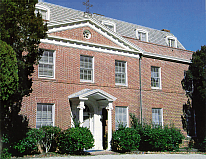 Listed now on the National Historic Register, Ridgeley Hall was designed by architect Julian Peabody and built around 1928 by Winthrop and Lucy Mercer Rutherford, who owned the property until 1944. It was acquired in 1950 from the Elberts of Long Island by the Sisters of Charity of Our Lady of Mercy.
Listed now on the National Historic Register, Ridgeley Hall was designed by architect Julian Peabody and built around 1928 by Winthrop and Lucy Mercer Rutherford, who owned the property until 1944. It was acquired in 1950 from the Elberts of Long Island by the Sisters of Charity of Our Lady of Mercy.
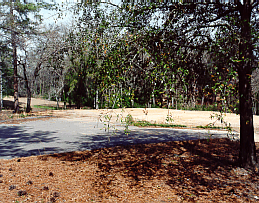 This photograph shows the grounds on which the school, conspicuous by its absence, once stood. This view, from Berrie Road, would have shown the main entrance and the gym.
This photograph shows the grounds on which the school, conspicuous by its absence, once stood. This view, from Berrie Road, would have shown the main entrance and the gym.
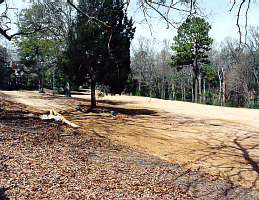 Looking west, the library was right of center of this view. You can see the residence on the extreme left. The tree left of center is the same tree pictured almost center in the first black and white newspaper photo above.
Looking west, the library was right of center of this view. You can see the residence on the extreme left. The tree left of center is the same tree pictured almost center in the first black and white newspaper photo above.
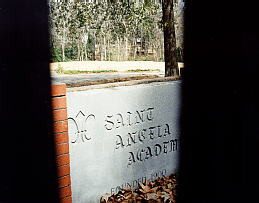 This was a tough shot, and for reasons other than photographic. Through the vertical slats in the fence separating Berrie Road from the schoolgrounds, I saw the St. Angela Academy marker. Perhaps that marker will stay there, assuming the sad role of gravestone. Above it, in the background, was the school.
This was a tough shot, and for reasons other than photographic. Through the vertical slats in the fence separating Berrie Road from the schoolgrounds, I saw the St. Angela Academy marker. Perhaps that marker will stay there, assuming the sad role of gravestone. Above it, in the background, was the school.
Astro4 hardware is provided by
Villanova University and
The Pew Charitable Trusts

http://astro4.ast.villanova.edu/saa/berrie.htm
Frank.Maloney@villanova.edu
 Listed now on the National Historic Register, Ridgeley Hall was designed by architect Julian Peabody and built around 1928 by Winthrop and Lucy Mercer Rutherford, who owned the property until 1944. It was acquired in 1950 from the Elberts of Long Island by the Sisters of Charity of Our Lady of Mercy.
Listed now on the National Historic Register, Ridgeley Hall was designed by architect Julian Peabody and built around 1928 by Winthrop and Lucy Mercer Rutherford, who owned the property until 1944. It was acquired in 1950 from the Elberts of Long Island by the Sisters of Charity of Our Lady of Mercy. Last month, St. Angela Academy, a former Catholic high school located on Berrie Road, was partially razed to the dismay of many former graduates of the school.
Last month, St. Angela Academy, a former Catholic high school located on Berrie Road, was partially razed to the dismay of many former graduates of the school.
 "I did attend St. Angela Academy when St. Angela Academy was on York Street," said Rosamond McDuffie. "There was a gorgeous white home on the property where the nuns and boarding students lived. There was a beautiful chapel on the first floor and the dining room was in there. We held tea dances on Sundays and we invited local boys in and the nuns chaperoned us. We spent wholesome and happy times there. I wept when they tore that building down; it was so sad.
"I did attend St. Angela Academy when St. Angela Academy was on York Street," said Rosamond McDuffie. "There was a gorgeous white home on the property where the nuns and boarding students lived. There was a beautiful chapel on the first floor and the dining room was in there. We held tea dances on Sundays and we invited local boys in and the nuns chaperoned us. We spent wholesome and happy times there. I wept when they tore that building down; it was so sad.
 "A lot of us went to that building on York Street," said Mary Catherine Cunning, older sister of Mrs. Anaclerio. "I graduated in 1953 and I was in the last graduating class in that building before it moved to Berrie Road. When we graduated, we had our reception on the grounds on Berrie Road but we didn't think that was unusual. In my recollection, it was a normal thing to do. The fact that we were the last class, I don't remember doing anything special because of that. But that didn't mean that much to us back then. We were young and excited about graduating and looking ahead to our futures. And, we didn't expect the school to be closing. It never entered our minds."
"A lot of us went to that building on York Street," said Mary Catherine Cunning, older sister of Mrs. Anaclerio. "I graduated in 1953 and I was in the last graduating class in that building before it moved to Berrie Road. When we graduated, we had our reception on the grounds on Berrie Road but we didn't think that was unusual. In my recollection, it was a normal thing to do. The fact that we were the last class, I don't remember doing anything special because of that. But that didn't mean that much to us back then. We were young and excited about graduating and looking ahead to our futures. And, we didn't expect the school to be closing. It never entered our minds."
 "It was absolutely devastating to us when it closed," said Mrs. Anaclerio. "It was worse than losing a member of our family. It was an institution. We were very upset when the county would not support the school. It had such a long and wonderful history, and Aiken lost a real gem when we lost that school. It's like anything else that you care passionately about."
"It was absolutely devastating to us when it closed," said Mrs. Anaclerio. "It was worse than losing a member of our family. It was an institution. We were very upset when the county would not support the school. It had such a long and wonderful history, and Aiken lost a real gem when we lost that school. It's like anything else that you care passionately about."
 Since then, the property has been unused, and last month, a work crew showed up at the former school to raze the building.
Since then, the property has been unused, and last month, a work crew showed up at the former school to raze the building.


